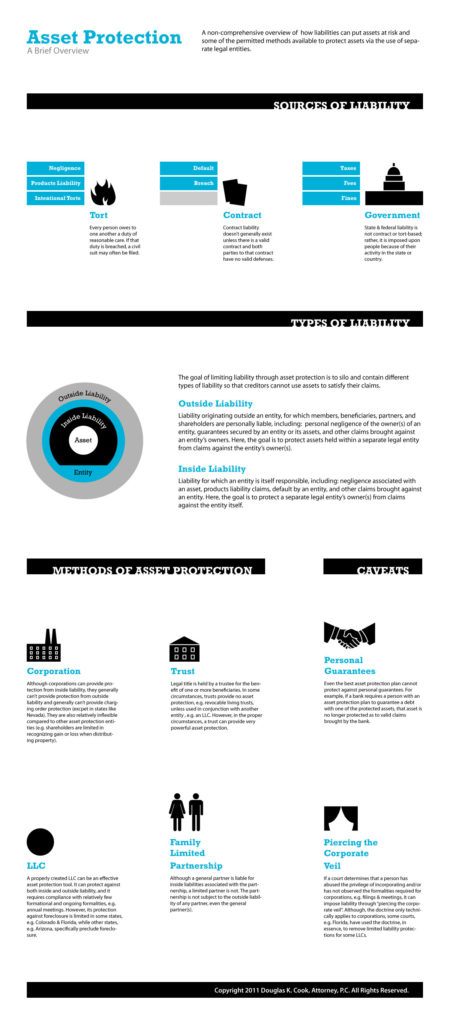People often associate estate planning only with directing the distribution of a decedent’s assets; however, estate planning is much broader and it can provide substantial utility to a person while he/she is still alive through a field of practice called asset protection.
Asset protection is the process of structuring the ownership of assets to minimize exposure to liability while still allowing the beneficial owners to benefit from the asset. It is not a single device that can be simply employed or elected. Rather, it involves the coordinated use of multiple legal disciplines, techniques, and tools tailored to the assets and circumstances of the individual. Below is a graphic that briefly summarizes the process.
As can be seen, while there are several aspects and steps involved in the creation of an asset protection plan, we’ll specifically focus on 1) the judicial remedies that creditors can pursue against property interests and 2) those separate legal entities that can be used to both protect assets from creditors and limit the liability associated with assets.
1) Judicial Remedies
Although there are several judicial remedies associated with creditors’ rights, the following two are of particular importance in terms of asset protection.
Foreclosure
When a court has issued a judgment against an individual (called a judgment debtor), the creditor can seek to foreclose upon the property interest(s) of the judgment debtor, which are susceptible to foreclosure until the judgment has been satisfied in full. Once a creditor forecloses upon a property interest, the creditor is entitled to all of the rights and required to fulfill all of the obligations associated with that interest.
Charging Orders
In contrast to foreclosure, creditors who obtain charging orders against judgment debtors’ interests are limited to receipt of the distributions associated with those interests – which distributions they cannot normally compel. Unlike foreclosure, creditors who obtain charging orders are not permitted to exercise the rights associated with the property interests against which a charging order has been entered.
While charging orders do protect the assets from creditors, they effectively stop the beneficial owner, against whose interest the charging order has been entered, from benefiting from the interest until the charging order is no longer effective unless the beneficial owner uses the charging order as leverage to substantially reduce any judgment entered, which often occurs.
Because foreclosure can permit a creditor to exercise control over assets, a well-designed asset protection plan should not allow creditors to pursue anything other than a charging order.
2) Separate Legal Entities
While there are several types of separate legal entities that can be utilized in an asset protection plan, depending upon the state in which they are formed, some are better suited than others to both protect the assets themselves from the reach of creditors and limit the liability associated with those assets.
Trusts
A trust is a legal relationship, in which a trustee holds legal title to an asset or assets for the benefit of one or multiple beneficiaries. If a trust that was not formed or created by a trust beneficiary and includes spendthrift provisions, the trust beneficiaries cannot assign their interests in the trust and creditors are precluded from obtaining anything but a charging order against a beneficiary’s interest in the trust.
Limited Partnerships (LP)
A traditional limited partnership requires the observance of more formational and operational formalities than general partnerships (which require none) but a limited partnership requires the observance of substantially fewer formalities than corporations, e.g. no annual reports and no additional tax returns if pass-through taxation is elected.
While limited partnerships do require that one general partner be liable for the debts of the partnership, they do limit such liability for the limited partners. However, limited partnerships do protect the partnership from the debts of both the general partner and the limited partner(s).
In contrast to a traditional limited partnership that requires a general partner to be liable for the debts of the limited partnership, a limited liability partnership (LLP) does not require that a general partner be so liable.
Limited Liability Companies (LLC)
LLCs generally also require few formational formalities (file articles of organization & publish notice of the filing) and operational formalities (no annual reports required). LLCs provide limited liability for the owners of the LLC (called members) for the debts of the LLC. In addition, creditors of LLCs in many states, e.g. Arizona, are expressly prohibited from foreclosing upon an LLC member’s interest and the rights associated with that interest.
What about corporations? Corporations require the observance of relatively more formational and operational formalities than the aforementioned entities and, unless incorporated in Nevada, corporation ownership interests (called shares) are subject to foreclosure.
Perhaps the single most important consideration in asset protection planning, is timing. An asset protection plan should be created and funded before creditor problems arise so as to help eliminate any suspicion of fraudulent transfer. If a transfer to an asset protection plan is deemed fraudulent, it will not be respected by the courts and can expose the asset owner to both civil and criminal liability.
This brief overview of some important considerations associated with asset protection is by no means comprehensive. Always seek the advice of a competent professional when making important financial and legal decisions.


One thought on “An Overview of Asset Protection”
Comments are closed.